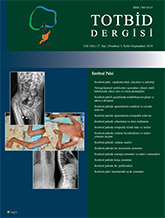
Cerebral palsy is a common static encephalopathy and can present as multiple musculoskeletal problems. Increased peripheral muscle tone causes joint contractures and decreased functional capacity. The risk for scoliosis increases parallel with the severity of musculoskeletal involvement. Scoliosis adversely affects the functional capacity, daily care, and nutrition in disabled children. Conservative treatments including physical therapy, bracing, and botulinum toxin injections do not prevent the progression of scoliosis in most of the patients, and surgical treatment becomes mandatory. The goals of surgery for the higher functioning patient are to provide a more normal spinal balance and alter the progression of disease, and to preserve function with respect to ambulatory potential; in the wheelchair-bound patient, the aim is to maintain independence in sitting and facilitate care. With the use of pedicle screws, three plane fixation is possible, making posterior instrumentation and fusion effective in correction of severe curves and obviating anterior surgery. The risk of complications, both perioperatively and postoperatively, is substantial but manageable with a careful preoperative workup, multidisciplinary care, and attention to detail.